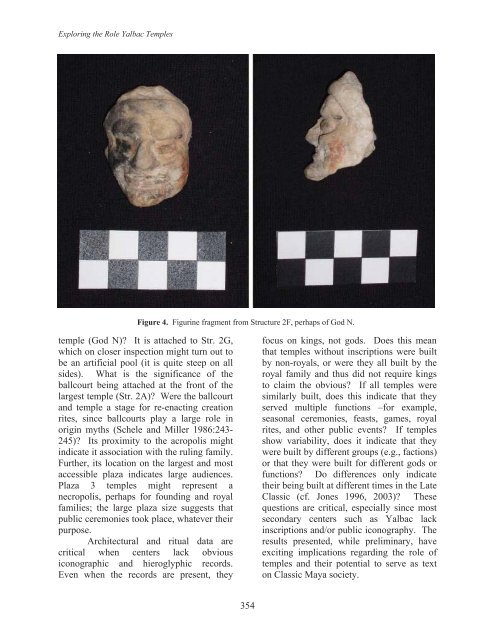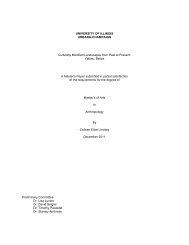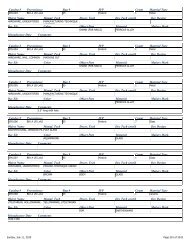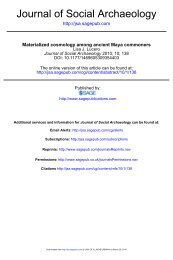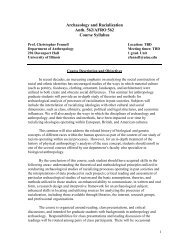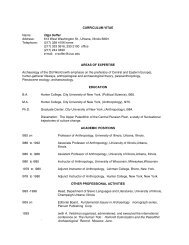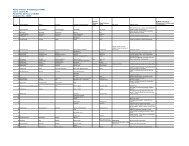<strong>Exploring</strong> <strong>the</strong> Role <strong>Yalbac</strong> <strong>Temples</strong>Figure 4. Figurine fragment from Structure 2F, perhaps <strong>of</strong> God N.temple (God N)? It is <strong>at</strong>tached to Str. 2G,which on closer inspection might turn out tobe an artificial pool (it is quite steep on allsides). Wh<strong>at</strong> is <strong>the</strong> significance <strong>of</strong> <strong>the</strong>ballcourt being <strong>at</strong>tached <strong>at</strong> <strong>the</strong> front <strong>of</strong> <strong>the</strong>largest temple (Str. 2A)? Were <strong>the</strong> ballcourtand temple a stage for re-enacting cre<strong>at</strong>ionrites, since ballcourts play a large role inorigin myths (Schele and Miller 1986:243-245)? Its proximity to <strong>the</strong> acropolis mightindic<strong>at</strong>e it associ<strong>at</strong>ion with <strong>the</strong> ruling family.Fur<strong>the</strong>r, its loc<strong>at</strong>ion on <strong>the</strong> largest and mostaccessible plaza indic<strong>at</strong>es large audiences.Plaza 3 temples might represent anecropolis, perhaps for founding and royalfamilies; <strong>the</strong> large plaza size suggests th<strong>at</strong>public ceremonies took place, wh<strong>at</strong>ever <strong>the</strong>irpurpose.Architectural and ritual d<strong>at</strong>a arecritical when centers lack obviousiconographic and hieroglyphic records.Even when <strong>the</strong> records are present, <strong>the</strong>yfocus on kings, not gods. Does this meanth<strong>at</strong> temples without inscriptions were builtby non-royals, or were <strong>the</strong>y all built by <strong>the</strong>royal family and thus did not require kingsto claim <strong>the</strong> obvious? If all temples weresimilarly built, does this indic<strong>at</strong>e th<strong>at</strong> <strong>the</strong>yserved multiple functions –for example,seasonal ceremonies, feasts, games, royalrites, and o<strong>the</strong>r public events? If templesshow variability, does it indic<strong>at</strong>e th<strong>at</strong> <strong>the</strong>ywere built by different groups (e.g., factions)or th<strong>at</strong> <strong>the</strong>y were built for different gods orfunctions? Do differences only indic<strong>at</strong>e<strong>the</strong>ir being built <strong>at</strong> different times in <strong>the</strong> L<strong>at</strong>eClassic (cf. Jones 1996, 2003)? Thesequestions are critical, especially since mostsecondary centers such as <strong>Yalbac</strong> lackinscriptions and/or public iconography. Theresults presented, while preliminary, haveexciting implic<strong>at</strong>ions regarding <strong>the</strong> role <strong>of</strong>temples and <strong>the</strong>ir potential to serve as texton Classic Maya society.354
L. LuceroAcknowledgments. I want to thank <strong>the</strong>Institute <strong>of</strong> Archaeology for <strong>the</strong>ir continuedsupport, especially Jaime Awe and JohnMorris. I also want to thank <strong>the</strong> organizers<strong>of</strong> <strong>the</strong> conference, especially SherilyneJones. Continued support from RobertVitolo is invaluable, as is th<strong>at</strong> from NewMexico St<strong>at</strong>e University and field schoolstudents Sandra Andrade, Joanne Baron,Adam Lujan, Ivy Luchetti, and ChadNorred. None <strong>of</strong> <strong>the</strong> fieldwork would havebeen possible without <strong>the</strong> support andfriendship <strong>of</strong> field assistants Zedikiah Scott,Cle<strong>of</strong>o Choc, Jose Ernesto Vasquez, IsabelAscencio (Don Luna), and Henry de Paz.Finally, I want to thank Nadine Gray fortaking time out from her dissert<strong>at</strong>ionresearch to conduct <strong>the</strong> chronologicalassessment <strong>of</strong> <strong>the</strong> ceramic assemblages.References CitedAbrams, Elliot M.1998 Sites as Structures: The ConstructionProcess and Maya Architecture. In Functionand Meaning in Classic Maya Architecture,edited by S. D. Houston, pp. 123-140.Dumbarton Oaks, Washington, D. C.Chang, K. C.1983 Art, Myth, and Ritual: The P<strong>at</strong>h toPolitical Authority in Ancient China.Harvard University Press, Cambridge.Graebner, Sean M.2002a Monumental Architecture and <strong>the</strong>Ancient Maya: The Royal Acropolis <strong>at</strong><strong>Yalbac</strong>, Central Belize. M.A. Thesis. NewMexico St<strong>at</strong>e University, Las Cruces.2002b Ancient Maya Royal Courts: <strong>Yalbac</strong>,Central Belize. In Results <strong>of</strong> <strong>the</strong> 2001 Valley<strong>of</strong> Peace Archaeology Project: S<strong>at</strong>urdayCreek and <strong>Yalbac</strong>, edited by L. J. Lucero,pp. 73-83. Report submitted to <strong>the</strong>Department <strong>of</strong> Archaeology, Ministry <strong>of</strong>Tourism and Culture, Belize.Graebner, Sean M., and Lisa J. Lucero2003 Residential <strong>Yalbac</strong>: Site 94N22N-14. InResults <strong>of</strong> <strong>the</strong> 2002 Valley <strong>of</strong> PeaceArchaeology Project: <strong>Yalbac</strong>, edited by L. J.Lucero, pp. 18-41. Report submitted to <strong>the</strong>Department <strong>of</strong> Archaeology, Ministry <strong>of</strong>Tourism and Culture, Belize.Hassan, Fekri1994 Popul<strong>at</strong>ion Ecology and Civiliz<strong>at</strong>ion inAncient Egypt. In Historical Ecology:Cultural Knowledge and ChangingLandscapes, edited by C. L. Crumley, pp.155-181. School <strong>of</strong> American <strong>Research</strong>Press, Santa Fe.Hocart, Arthur M.1970 [1936] Kings and Councillors: An Essay in<strong>the</strong> Compar<strong>at</strong>ive An<strong>at</strong>omy <strong>of</strong> Human Society.Edited by R. Needham. University <strong>of</strong> ChicagoPress, Chicago.Hooper, John M. D.2004a Energetic Investment in <strong>the</strong> Acropolis<strong>at</strong> <strong>Yalbac</strong>, Belize: A Compar<strong>at</strong>iveApproach. M.A. Thesis. New Mexico St<strong>at</strong>eUniversity, Las Cruces.2004b <strong>Yalbac</strong>’s Royal Acropolis: Looter’sTrench Oper<strong>at</strong>ions. In Results <strong>of</strong> <strong>the</strong> 2003Valley <strong>of</strong> Peace Archaeology Project:<strong>Yalbac</strong>, edited by L. J. Lucero, pp. 13-35.Report submitted to <strong>the</strong> Institute <strong>of</strong>Archaeology, N<strong>at</strong>ional Institute <strong>of</strong> Cultureand History, Belize.Jones, Christopher1996 Excav<strong>at</strong>ions in <strong>the</strong> East Plaza <strong>of</strong> Tikal.Tikal <strong>Reports</strong> No. 16. University MuseumPublic<strong>at</strong>ions. University <strong>of</strong> Pennsylvania,Philadelphia.2003 The Tikal Renaissance and <strong>the</strong> EastPlaza Ball Court. In Tikal: Dynasties,Foreigners, and Affairs <strong>of</strong> St<strong>at</strong>e, edited by J.A. Sabl<strong>of</strong>f, pp. 207-225. School <strong>of</strong>American <strong>Research</strong>, Santa Fe.Loten, H. Stanley2003 The North Acropolis: Monumentality,Function, and Architectural Development.In Tikal: Dynasties, Foreigners, and Affairs<strong>of</strong> St<strong>at</strong>e, edited by J. A. Sabl<strong>of</strong>f, pp. 227-252. School <strong>of</strong> American <strong>Research</strong>, SantaFe.Lucero, Lisa J.2004 <strong>Exploring</strong> Classic Maya Politics:<strong>Yalbac</strong>, Central Belize. In Archaeological355


